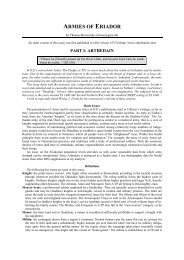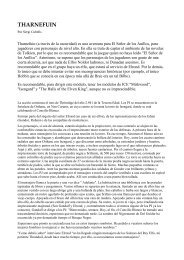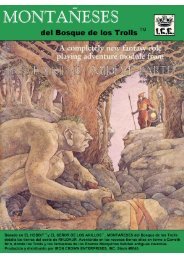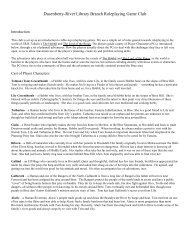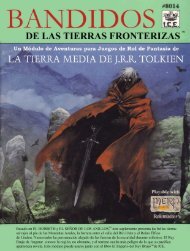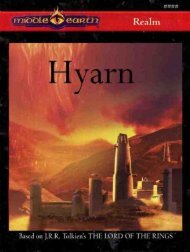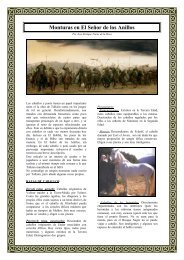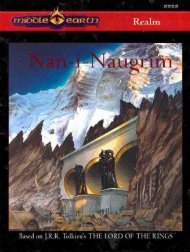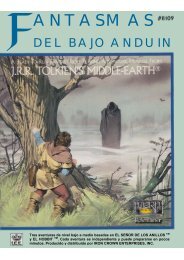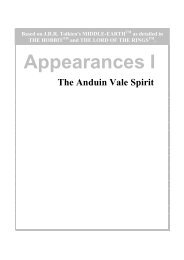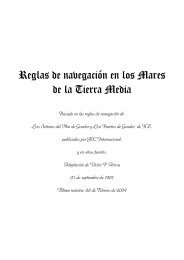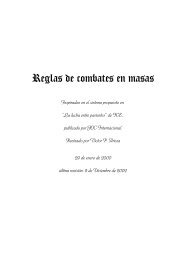bon olivier (order #42065) 83.114.187.4 - Fan Modules - Free
bon olivier (order #42065) 83.114.187.4 - Fan Modules - Free
bon olivier (order #42065) 83.114.187.4 - Fan Modules - Free
You also want an ePaper? Increase the reach of your titles
YUMPU automatically turns print PDFs into web optimized ePapers that Google loves.
side wide, low workbenches; potters<br />
require wheels and kilns; and coopers,<br />
leatherworkers, and others have<br />
arrangements appropriate to their<br />
specialties. One thing common to<br />
all workshops and living spaces in<br />
the Seventh Portion, however, is that<br />
they are the most beautiful in all<br />
of Isengard. Most rock and wood<br />
surfaces have been chiselled over the<br />
years with pleasing designs. Nearly<br />
all the furniture is well-crafted. Tools<br />
and implements are beautiful as well<br />
as practical. Knobs, hooks, and other<br />
items forged from black iron are often<br />
cast to resemble leaves, flowers, or<br />
animals. Over the years, and in all<br />
of the fortress' historical periods, the<br />
craftsmen housed here have been<br />
most capable of making their dwellings<br />
lovely.<br />
When the Men of Gondor lived<br />
in Isengard, the tradesmen of the<br />
Seventh Portion sold their products<br />
not only to the local lord but also to<br />
the people of the vale beyond, setting<br />
their own prices, paying a portion of<br />
their earnings to the tower, and keeping<br />
their profits. The Dunlendings<br />
were more clannish, with everyone<br />
working for the good of the family.<br />
Saruman, however, claims ownership<br />
of everything within Isengard, and the<br />
tradesmen here produce their crafts<br />
only for him, and, occasionally, for<br />
those he designates. They receive no<br />
money for their work, but are housed<br />
and fed, and can requisition the items<br />
they need from the stores of the Sixth<br />
Portion, and from other craftsmen.<br />
eighth portion:<br />
stables<br />
The final, Eighth Portion of the<br />
ring-wall stands directly east of the<br />
main gate, and contains stabling for<br />
all of the horses of Isengard. (Warg<br />
pens are located underground; see<br />
‘Pens’ on page 53.) Most stabling<br />
chambers are located close to the<br />
interior face of the ring-wall rather<br />
than deep within its stone. Many,<br />
in fact, are long chambers with only<br />
three walls, open for their length onto<br />
the basin itself. This arrangement is<br />
ideal for horses that might otherwise<br />
become uneasy in underground confines.<br />
Some open stables have wooden<br />
fences that section the stables from<br />
the open ground of the basin, but this<br />
is not the rule. The stables of Isengard<br />
are rarely full to capacity. Although<br />
horses and other beasts of burden can<br />
be useful for toil, Saruman has turned<br />
his attention to other creatures of<br />
labour—Orcs and Half-orcs.<br />
t h e b a s i n<br />
‘[A] great circle, somewhat hollowed like<br />
a vast shallow bowl… . Once it had<br />
been green and filled with avenues… .’<br />
— The Two Towers<br />
Within the ring-wall lies not only<br />
the tower of Orthanc, but also<br />
the great shallow basin that surrounds<br />
3<br />
The Fortress of Iron<br />
it. This space measures a mile across,<br />
and is almost perfectly round. It is<br />
slightly bowl-shaped, but so subtly<br />
that the incline is easy to miss. When<br />
the Men of Westernesse first began<br />
shaping Isengard this basin was filled<br />
with ash, a fine loose grey dust that<br />
floated upward with every footfall.<br />
Dirt was laid atop it, and trees and<br />
flowers planted. The ash provided<br />
the soil with rich nutrients, and the<br />
vegetation flourished.<br />
When the Dunlendings claimed<br />
Isengard, the flora grew wild and<br />
untamed, the basin full of thick bushes,<br />
dense plants, ponderous trees, and<br />
tall grasses. They ignored it all, using<br />
the roads to traverse the bowl. These<br />
Men were warriors rather than farmers,<br />
and had no interest in taming the<br />
plant life.<br />
When Saruman came to Isengard,<br />
he brought a love of elegant <strong>order</strong>.<br />
Wild shrubs were pruned, trees cut<br />
back, grasses trimmed, and whole<br />
sections reseeded with flowering<br />
plants. Under his guidance, the basin<br />
<strong>bon</strong> <strong>olivier</strong> (<strong>order</strong> <strong>#42065</strong>) 8




